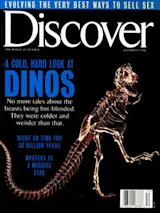Most of the technologies that create three-dimensional images-- from virtual-reality helmets to holograms to the cheap glasses handed out for watching 1950s 3-D movies--are grounded in deception. In one way or another, they all trick the eye into converting flat images to three- dimensional ones. Stanford engineer Elizabeth Downing has broken with that tradition of visual subterfuge. She recently developed a fundamentally new way of creating three-dimensional images. Her images--which can be made to move--actually have height, length, and width, all in an inch-high cube.
Downing downplays her efforts. A lot of problems that engineers have solved are complex, she says. This one, in many regards, is trivial. Most engineers would demur. Her cube is an elegant and subtle solution to a problem that has stumped many of her colleagues.
Downing’s cube exploits one of the most fundamental interactions between light and matter. When a particle of light, or photon, ...














